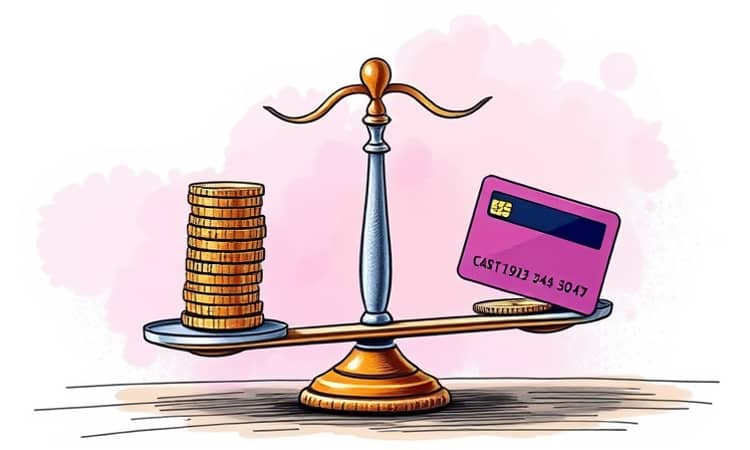Borrowing money can feel daunting, but understanding your options is key to making confident financial decisions. In this article, we explore the core differences and similarities between personal loans and credit cards, guiding you to choose the right tool for your needs.
Understanding Borrowing Structures
The first major distinction lies in how these credit products are structured. Personal loans deliver a lump sum disbursed upfront, ideal for planned large expenses. Once approved, you receive all the funds at once and repay them over a fixed period.
Credit cards, by contrast, offer a revolving line of credit available. You borrow as needed up to your limit, repay, and borrow again. This flexibility suits everyday spending and emergencies but can tempt overspending if not managed carefully.
Interest Rates and Associated Costs
Interest is perhaps the most critical factor. Personal loans typically feature potentially lower overall borrowing costs thanks to fixed APRs that range from 6% to 36%, with an average of 12.43% for borrowers with good credit. This predictability helps you budget without fearing rate hikes.
Credit cards usually carry higher, variable APRs between 18.68% and 24.72%. However, many issuers offer 0% APR on purchases or balance transfers for 6–18 months. If you can clear balances during these promotional windows, you can effectively borrow interest-free, but failure to pay in full triggers standard rates and compounding interest.
Loan Amounts and Limits
Personal loans often provide access to larger sums—anywhere from $1,000 up to $100,000 or more—depending on your creditworthiness and lender policies. This makes them well suited for significant undertakings like home improvement or debt consolidation.
Credit card limits are usually lower, commonly between $1,000 and $10,000 for standard cards, though premium cards may exceed $40,000. These limits replenish as you repay balances, offering ongoing access to funds but capping the maximum available at any one time.
Repayment Terms and Flexibility
Personal loans require predictable monthly payments over time. You’ll have a set repayment period—typically one to seven years—ensuring the debt is fully paid off by a known date. This structure fosters disciplined budgeting and prevents runaway debt.
Credit cards allow flexible repayment, with minimum payments due each month. While this can ease cash flow in tight months, it also means carrying balances longer and accruing interest. The fluctuating balance and variable payments demand strong self-control to avoid long-term debt traps.
Fees, Rewards, and Incentives
Most personal loans charge origination fees—usually 1%–8% of the loan amount—along with potential prepayment penalties and late fees. They rarely offer rewards, focusing on straightforward financing instead of perks.
Credit cards, conversely, can impose annual fees, late fees, cash advance fees, balance transfer fees, and foreign transaction fees. In exchange, issuers often sweeten the deal with cash back, travel points, and introductory bonuses. The value of these incentives can offset costs if you use the card strategically.
Impact on Your Credit Profile
Both personal loans and credit cards affect your credit score. On-time payments strengthen your history, while missed payments can inflict significant damage. Credit cards also involve the manage your credit utilization ratio, meaning high balances relative to limits can lower your score even if you pay on time.
Personal loans, once funded, don’t impact your utilization ratio but do add to your overall debt load. Both options involve a hard credit inquiry when you apply, which can temporarily dip your score. Responsible management of either credit tool can yield long-term score improvements.
Choosing the Right Option for You
Your circumstances and goals determine the ideal choice. Consider these scenarios and factors:
- When you have a large, planned expense or wish to consolidate multiple high-interest debts, a personal loan offers predictability and often lower rates.
- If you need everyday purchasing power, want to leverage rewards programs, or anticipate fluctuating spending, a credit card provides unmatched flexibility.
- Introductory 0% APR promotions on credit cards can be useful for short-term interest-free borrowing, but only if you have a solid repayment plan.
Key decision factors include:
- Your ability to make consistent monthly payments versus fluctuating minimum payments.
- The total cost of credit, considering interest rates, fees, and potential rewards.
- Your credit score and history, which influence the rates and limits you’ll qualify for.
Conclusion
Personal loans and credit cards each play a distinct role in personal finance. Understanding these differences empowers you to select the option that aligns with your financial objectives, whether that’s consolidating debt, funding a major purchase, or managing daily expenses.
By weighing interest rates, repayment terms, fees, and the impact on your credit profile, you can craft a borrowing strategy that supports your goals and keeps you on a path to financial health. Remember: responsible borrowing and timely repayments are the cornerstones of building a strong credit future.














